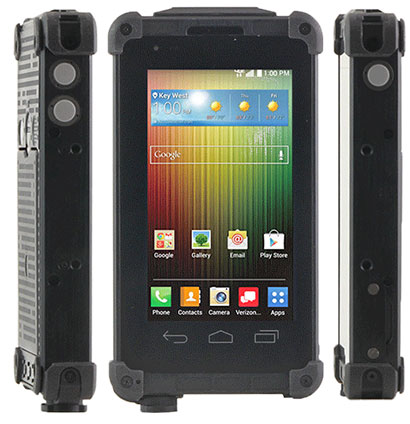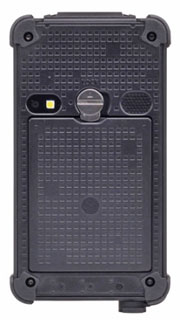Based in El Monte, California, AMREL (AMerican RELiance) has a long history of offering value-added applications in vertical markets. The Rocky line of ruggedized computers was introduced in 1995 and has been updated, enhanced, and fine-tuned every since. AMREL also offers innovative rugged handhelds for both military and industrial applications, and their DF7A, officially launched July 14, 2015, is a good example of how embedded systems products can provide exemplary modularity and flexibility.

For those unfamiliar with Amrel's lineup, the Rocky DF7A is a follow-up product to the Rocky DF6, which was introduced in Fall 2013. The new product shares the dimensions, look and feel of the initial one, but is an updated Android-only device, whereas the DF6 was originally supposed to be available with either Windows Embedded CE 6.0 or Android. From what we can tell, the DF6 is now Windows-only with the original specs, whereas the DF7A benefits from some tech and interface updates, and is Android-only.
While the DF7A looks like a small industrial tablet computer, it's really a rugged handheld. With its wide-format sunlight-viewable display that measures five inches diagonally and offers 480 x 800 pixel WVGA resolution, the DF7A has the display real estate of a modern smartphone. Compared to the DF6, the biggest noticeable difference, apart from using Android instead of Windows CE, is that the newer device uses capacitive multi-touch instead of a resistive digitizer.
 As is evident from the pictures above, the DF7A is remarkably compact and slender for a fully rugged device. It measures 3.7 x 6.7 inches — a footprint just a bit larger than that of an iPhone 6 Plus — and is just under an inch thick.
As is evident from the pictures above, the DF7A is remarkably compact and slender for a fully rugged device. It measures 3.7 x 6.7 inches — a footprint just a bit larger than that of an iPhone 6 Plus — and is just under an inch thick.
That makes the DF7A considerably smaller and handier than even a compact 7"-class tablet. It can be carried pretty much anywhere. It also weighs just 14.4 ounces, a big plus for military and many other demanding field applications where personnel can't afford to be weighed down by equipment.
The DF7A is powered by a replaceable and externally accessible 13 watt-hour Li-Ion battery, with an optional 26 watt-hour battery also available. AMREL says that's good for 4.5 and 9 hours of operation, perhaps a bit marginal for this type device. For situations where DC power is preferable, there's optional 5V sealed DV-in via a sealed LEMO connector (see LEMO site).
The picture above left shows the backside of the DF7A, which shows the accessible battery compartment, the mono-speaker, and the optional 5-megapixel auto-focus documentation camera with illuminator.
The device is powered by a 1.2GHz quad-core Qualcomm MSM8225Q "Snapdragon" ARM Cortex-A5 processor, a mature, proven and quite popular chip that's a step up from the 1.0GHz Texas Instruments AM3715 used in the original DF6.
What truly sets the DF6/DF7A platform apart is its superior configurability. As is shown in the column to the right, the bottom of the device can accommodate up to three sealed Fischer connectors (see Fischer Connector website), each of which can accommodate either RS232 serial, USB, LAN, VGA or headset functionality. The top, likewise is highly configurable; customers can order the device with an antenna for one of the optional radios (i.e., WiFi, Bluetooth, WWAN or GPS), and there are two SMA (SubMiniature version A) connectors for those radios as well. This degree of configurability for the job is rarely available, and represents one of the advantages of Amrel's embedded system device architecture.
Since Amrel targets the DF7A for deployment in environmentally demanding applications, the device is built to operate within a wide -4 to 122 degree Fahrenheit temperature range, and it has been independently certified to MIL-STD 810G for shock, vibration, rain, humidity, salt fog, altitude, solar radiation, explosive atmosphere, temperature shock and more. It is also sealed to IP66 level, where the first "6" means it's totally sealed against dust, and the second "6" that it is also protected against even strong jets of water.
With the DF7A, Amrel is making a firmer commitment to Android by offering this new version Android-only, with the familiar Android Back/Home/menu icons, tech updates that include not only the quicker processor but also twice the RAM and Flash storage, and capacitive multi-touch, which works much better with Android than the resistive digitizer used in the DF6. Add to that the platform's inherent flexibility, configurability and superior ruggedness, and this new Amrel handheld looks like an attractive proposition indeed.



